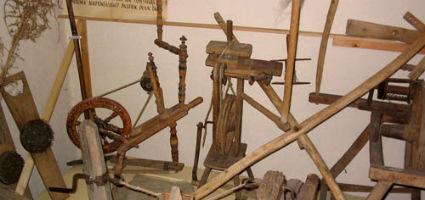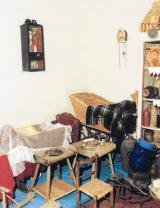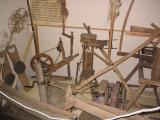2024. April 26. Friday
Region Histiorical Collection - Jászágó
 |
Address: 5124, Jászágó Kókai László tér 2.
Phone number: (57) 426-020, (57) 526-020
E-mail: jaszago@vnet.hu
Opening hours: Anytime on prior notice
|
The small town of Jászberény is situated on 3600 acres between Jászárokszállás and Pusztamonostor. Macadam leads to Jászberény from the above-mentioned two villages.
When it is clear, it is possible to see the hills of the Mátra from the small town. The Ágói Stream originating in the Nagy-Hársas turns towards the south around the middle of the village. It is a land full of forests and meadows. Only part of the old vineyards is cultivated for vegetable production.
The name Ágó was first mentioned in 1450. The small town was an important settlement of the Jászság then since it had a church where a priest served and a lord lieutenant. A little less than a hundred and a half years later, the Turkish army burned the village down.
Most of the people living in the village moved to Árokszállás. Pentz mentioned it in the records of 1699 as an independent unit. The number of graves in the village was over a hundred. The Jász took part in the redemptions of 1745. The village began to be repopulated in the 18th century. A hundred years later, several homesteads were located around the village.
The Jász 'redempts' applied traditional farming but also used machines and new technology in agriculture. However, since they lacked education, they were defenseless against free trade. Even though they applied for the establishment of an elementary school, it was only opened after WWI despite the fact that establishment of elementary schools in every village were obligatory according to the school law of 1868. Only 'wildcat' schools were open. In 1924, the first homestead peoples' school opened in the village. Later, it was expanded in the framework of the Klebelsberg action. With this, a kind of social life came to existence in the homesteads.
Following WWII, the settlements system was administered. The village bares the name of the Jászság since 1952. Ever since then, many of the homesteads disappeared and the people moved into the villages. First watering was applied in agriculture, later the growing of vegetable. Institutions were built to operate the village, as well as water, gas, telephone network. Its trade is mainly based on comestible and catering trade. A collection on local history, school history and ethnography is open for the visitors.
The compilation was founded in 1962 when the Jászság was latched on to the national electric network. The first exhibition on local history was part of the program series organized to commemorate the event.
The exhibition holding ethnographic and archeological material was organized in two wards. The local study group on local history for adults formed in 1963. Its objective was to research the past of the village. As the result of field trips to the outskirts, the collection grew with several objects.
Macsi Sándor
When it is clear, it is possible to see the hills of the Mátra from the small town. The Ágói Stream originating in the Nagy-Hársas turns towards the south around the middle of the village. It is a land full of forests and meadows. Only part of the old vineyards is cultivated for vegetable production.
The name Ágó was first mentioned in 1450. The small town was an important settlement of the Jászság then since it had a church where a priest served and a lord lieutenant. A little less than a hundred and a half years later, the Turkish army burned the village down.
Most of the people living in the village moved to Árokszállás. Pentz mentioned it in the records of 1699 as an independent unit. The number of graves in the village was over a hundred. The Jász took part in the redemptions of 1745. The village began to be repopulated in the 18th century. A hundred years later, several homesteads were located around the village.
The Jász 'redempts' applied traditional farming but also used machines and new technology in agriculture. However, since they lacked education, they were defenseless against free trade. Even though they applied for the establishment of an elementary school, it was only opened after WWI despite the fact that establishment of elementary schools in every village were obligatory according to the school law of 1868. Only 'wildcat' schools were open. In 1924, the first homestead peoples' school opened in the village. Later, it was expanded in the framework of the Klebelsberg action. With this, a kind of social life came to existence in the homesteads.
Following WWII, the settlements system was administered. The village bares the name of the Jászság since 1952. Ever since then, many of the homesteads disappeared and the people moved into the villages. First watering was applied in agriculture, later the growing of vegetable. Institutions were built to operate the village, as well as water, gas, telephone network. Its trade is mainly based on comestible and catering trade. A collection on local history, school history and ethnography is open for the visitors.
The compilation was founded in 1962 when the Jászság was latched on to the national electric network. The first exhibition on local history was part of the program series organized to commemorate the event.
The exhibition holding ethnographic and archeological material was organized in two wards. The local study group on local history for adults formed in 1963. Its objective was to research the past of the village. As the result of field trips to the outskirts, the collection grew with several objects.
Macsi Sándor

